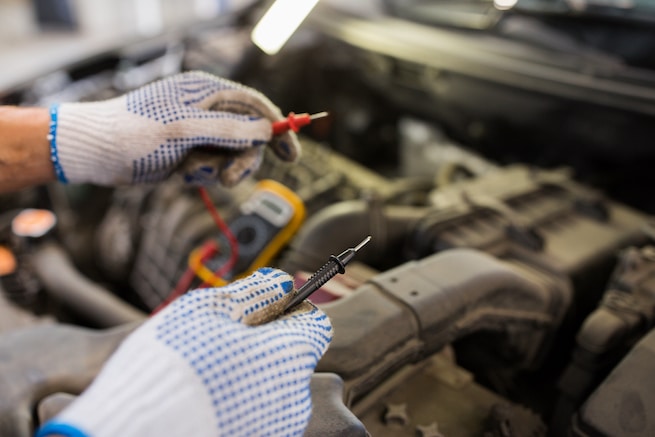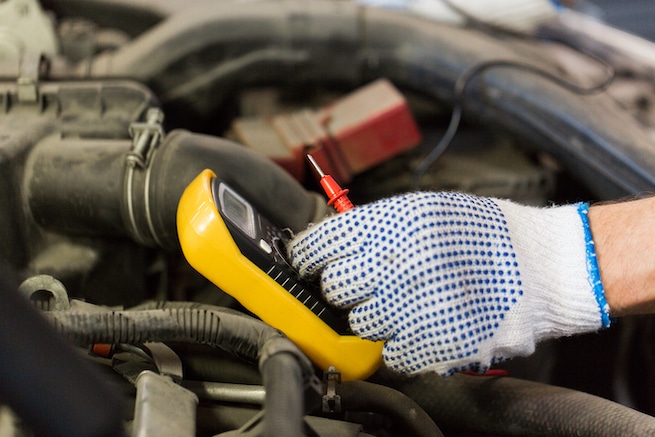Gain Access To 7 Common Causes of Parasitic Battery Drain
The car’s battery is crucial for the overall performance and efficiency of the vehicle. It supplies the needed electricity to power different electrical components like the starter.
It functions by converting chemical energy to electrical energy to get the vehicle started. However, car batteries can wear out over time, like other car parts.
Usually, you can experience parasitic draw, also called parasitic battery drain. Because of this type of issue, you’ve probably had to use a battery charger to jumpstart your car more than once.
Before you go ahead and purchase a new battery, it is important to identify the root cause of the problem. We’ll go over the most common causes of parasitic battery drain and some steps you can take to resolve the issue.
Parasitic Battery Drain Defined

Parasitic battery drain is when your car’s electrical system continues to pull energy from the battery despite the fact that the automobile is completely turned off. The electricity still drains the battery even though everything is off.
Don’t panic; it is normal in most vehicles. Meanwhile, if the electricity amount is pulled beyond the normal range, it can be a problem affecting the performance and lifespan of your vehicle battery.
Causes of Parasitic Drain On A Car Battery
The usual parasitic draw amount is around 50 to 85 milliamps for modern vehicles and less than 50 milliamps for older cars. Many factors can cause a parasitic draw, which includes short circuits or electrical systems that remain energized, like:
- Trunk light of older vehicles
- Under-hood or glove-compartment lighting
- Relay switches
- Dome light
- Cell phones
- Headlight
- Alarm system
- Computer module
- Windshield wipers
- Light radio settings on the display
To help you understand more, the following are the top main causes of parasitic battery drain:
Faulty Alternator Diodes
The vehicle’s alternator comes with six diodes that convert AC (alternating current) to DC (direct current), wherein the battery runs. If the diode is lousy, it can impact the alternators, which prevents the car battery from charging.
Electrical Components or Short Circuits
Electrical devices, including the trunk, relay switches, under-hood/glove lighting, headlight, and computer module, can lead to parasitic drains since they remain energized.
Use a fuse puller to remove the fuses from the fuse box and visually inspect for any signs of discoloration or melting, which could indicate a short circuit.
Faulty Battery
Another cause of parasitic battery drain is an old battery with weak cells, even if you recharge it repeatedly. Try unplugging optional equipment to see if enough electricity remains to turn over the engine.
If the alternator recharges the battery but it continues to discharge, the problem may be that its cells are not capable of holding a charge.
7 Factors That Can Cause Parasitic Battery Drain

The alternator in your car may have a bad diode that hurts the battery and makes it unable to hold a charge. The alternator needs to supply a fresh charge to the battery.
A failing diode indicates that the alternator is not producing enough amp draw to keep the battery charged. Car battery drain can also happen due to the following reasons:
#1 The Battery is Old or Worn Out
Your battery will not last forever. In most cases, it can only last for about five years. It can depend on how you drive, your location, and how often you use it.
Frequent short trips, extreme temperatures, and daily use can reduce the lifespan of your vehicle’s battery. So, if your car battery is dying quickly, even after the jump start, you may need a new car battery.
#2 Battery Connections Can Be Corroded or Loose
There are some instances where the positive and negative battery terminals can be loose or corroded. If the battery terminals are corroded or loose, the car battery will not transmit its power correctly.
The electrical component of your car can be stalled or damaged while driving. Cleaning the batteries of your car regularly can help avoid corrosion-related problems. Use a battery terminal cleaner to remove corrosion, and check the tightness of the terminals to ensure proper contact.
#3 The Battery is Not Charging as You Drive
As you start the engine, your vehicle relies on its battery. Your automobile’s battery depends on the alternator for its ability to charge when it is running. If the alternator is not functioning correctly, it will not charge the battery efficiently.
It will not start your vehicle, even if you are only driving. The alternator can be the culprit for why the car doesn’t turn on after you drive it.
To test this, you will need to remove the negative battery cable and use a multimeter to measure the voltage output. It is safer to use the negative battery post for this, as it won’t damage the electrical system of your car.
#4 Something Creates a “Parasitic Attraction”
The car battery powers alarm systems, radios, and clocks even if the vehicle is not in use. These things will not affect your battery. Interior lights, bad relays, and door lights can lead to parasitic drains.
Your alternator charges your vehicle’s battery as the engine runs. It means that you don’t have to worry about the battery going flat while driving.
On the other hand, if the engine is off, the alternator can’t recharge the car battery. It can cause electrical mishaps that can drain the battery completely. Parasitic draw is described as battery strain, which electrical problems can cause.
You can avoid parasitic battery draw by turning off the lights. In addition, check if the glove box, trunk, and doors are tightly closed before leaving your vehicle.
#5 It Is Very Cold or Extremely Hot Outside
The battery of your vehicle can be damaged by hot weather or freezing winter temperatures. Newer batteries have greater resistance to extreme temperatures. If the vehicle battery is old, extreme heat or cold can make it faulty or even kill you.
#6 The Headlights Are Off
You should check the lights if your vehicle’s battery is constantly draining. Most modern vehicles have headlights that turn off automatically after a specific time. If your car lacks this feature, the headlights will work continuously until the battery is turned off or fully charged.
#7 You Have Too Many Short Trips
The cranking engine needs more power, but the alternator charges the battery as it runs. If you drive a lot with an older battery, your alternator may not recharge the battery correctly. Long-term short trips can decrease the lifespan of your vehicle’s battery.
What Are the Symptoms of a Worn Battery?
Over time, your vehicle’s battery will wear down, which can lead to a parasitic battery drain. With this, you will need to replace it. Usually, batteries can show warning signs that they are already worn out.
So, you should be aware to avoid several problems. Some symptoms of a worn vehicle battery include the following:
Clicking/ Cranking
Once you turn on the key with the ignition, the battery sends a current to your starter to make the vehicle run. If you find it challenging to get the vehicle to start and hear excessive cranking or clicking, you may have a battery problem.
Backfiring
Failing vehicle batteries may lead to intermittent electricity sparks, igniting built-up fuel in the cylinders and creating a backfire.
Dim Headlights
It is possible to start your vehicle if your battery is wearing down. However, if you observe that the headlights are weaker or dim, it can be a warning that you have an almost dead battery and cannot power electrical components fully.
Dashboard Lights, but Not Starting
It is hard to determine a weakening battery if other electrical components are functioning, but the vehicle is not starting. You can observe that the dashboard lights or radio turns on, but the battery cannot energize the starter.
Increased Jump Starts
If you jumpstart your vehicle more often, it is time to get a replacement battery. Low battery power occurs when the battery cables are loose or corroded.
Parasitic Battery Drain Test
Using a digital multimeter, you will know how much draw is being put on vehicle batteries. A multimeter is an essential tool for diagnosing the current and electrical draw on the part. With the ignition off, you can connect the multimeter.
Remember to practice safety measures and wear eyewear and protective gloves. If there is an excessive draw from the battery, finding where the drain is coming from is a more in-depth procedure.
It needs to pull out different fuses, so you can seek help from a professional automotive technician to handle the job.
What are the Parasitic Drain Test Methods?
Parasitic draws can be determined by conducting the following methods. These tests can help you identify the culprit for the abnormalities in your vehicles.
Faulty Alternator Diode Test
The headlight of your vehicles will dim with a lousy alternator diode. It will drain the battery overnight. It can prevent electrical energy from flowing to different electrical devices. You can set the voltmeter on the AC voltage scale to a low setting.
As the motor works, touch the meter probes to the battery terminals of the auto, positive to the positive terminal and negative to the negative terminal. If you record over 0.5 ACV, there are two or more lousy diodes.
Battery Hydrometer Test
With this test, you can quickly check your battery’s condition. If it needs a charge or the cell fails, perform this method with batteries with removable caps. If the hydrometer level reads below 1.265, it needs a charge.
Amperage Battery Drain Test
The amperage battery drain test is also a popular and efficient method. However, it is not effective for old cars due to the challenges of computer modules. You can identify the electrical systems in your model’s repair manual. It will indicate if there’s an increase of 1 Amp.
Voltage Drop Battery Drain Test
It is a simple test for locating faulty circuits without moving the computer modules. It is essential to use a digital multimeter for voltage tests. Make sure it is fully charged, and clean the meter probes for accurate readings.
Parasitic Battery Drain Fixing Costs
It is essential to diagnose the parasitic drain to find the best solution to the problem. The overall price to fix this issue depends on whether you have a bad alternator diode, electrical issues, a faulty fuel pump, battery problems, or just loose wires.
When it comes to testing, a parasitic drain fix costs around $35 to $44. Then, the labor fee can be $35 to $44, excluding taxes and other costs. If you’re unsure about fixing the battery’s problem, seek the assistance of a professional.
Conclusion
Generally, a parasitic drain can be a costly problem. It can cost you money and be very dangerous. You can apply the tips mentioned in this article to prevent parasitic drains and enjoy the best possible service life of your automobile’s battery.
If you leave your trickle charger on and the battery does not receive the required voltage, there could be other issues, such as faulty connections or corroded battery terminals. The issue can also rely on a few blown fuses on the fuse panel.
Extreme weather can also impact the battery’s ability to charge, so it is important to make sure that your auto is stored in a sheltered location and that all electrical connections are clean. If your battery drains overnight, simply disconnect the negative cable from the negative post of the battery.
Last Updated on: March 16, 2025

